Housing statistics quarterly update: March 2022
A summary of activity in new build housing, affordable housing and long term empty properties and second homes in Scotland.
2. All-sector new housebuilding
Chart 1 on page 1 shows that annual all-sector new build starts and completions in the years to end June both showed a broadly decreasing direction of trend following the financial crisis in 2008. Starts fell until to a low in 2011 and completions reached their lowest point in 2013. Following this, starts and completions have then generally increased year on year, reaching a peak in 2019, before dropping due to the impact of COVID-19 lockdown measures in 2020. Starts and completions have since picked up in 2021 following the easing of these restrictions, with starts up by 4% and completions up by 10% in the latest year to end June 2021.
Chart 2 below presents the latest quarterly trends in completions to end June 2021. There were 4,897 all-sector completions in the latest quarter April to June 2021. This is an increase of 4,176 homes on the 721 completions in the same quarter in 2020, in which COVID-19 lockdown measures were in place. April to June 2021 completions were however 12% (640 homes) below the same quarter in 2019.
The 3,651 private sector led completions in April to June 2021 is an increase of 2,964 homes compared to April to June 2020. However completions were 20% (911 homes) lower than the same quarter in 2019. The 555 local authority completions in April to June 2021 is an increase of 521 homes on the 34 completions in April to June 2020, and is also an increase of 24% (109 homes) on the same quarter in 2019. The 691 housing association completions in April to June 2021 is 691 homes higher than same quarter in 2020, in which there were no completions. This figure is also 31% (162 homes) higher than the same quarter in 2019.
Over the latest 12 months, there have been 18,974 all-sector new build homes completed in in the year to end June 2021. This is an increase of 10% (1,751 homes) on the 17,223 completions in the previous year. However the latest annual figure is below the 21,603 homes completed in the year to end June 2019. Increases in the latest have been seen across private-led completions (12% or 1,495 homes) and local authority completions (83% or 876 homes). Housing association completions however dropped by 17% or 620 homes.
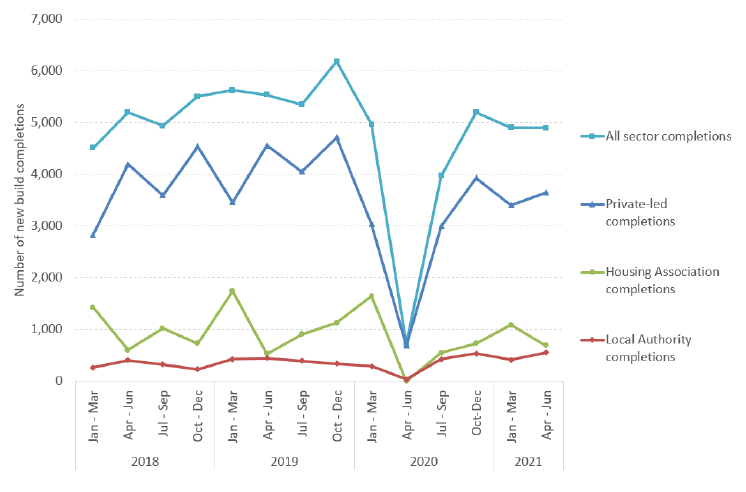
Chart 3 shows the quarterly trends in starts, in which there were 5,471 all-sector homes started in April to June 2021, an increase of 4,181 compared with April to June 2020 when lockdown measures were in place. However starts were 5% (298 homes) lower than the same quarter in 2019.
The 4,559 private sector led starts in April to June 2021 is an increase of 3,686 homes compared to April to June 2020, and is also a slight increase of 10 homes on April to June 2019. The 584 local authority starts in April to June 2021 is an increase of 571 homes on the 13 starts in April to June 2020, and is also an increase of 14% (71 homes) on the same quarter in 2019. The 328 housing association approvals in April to June 2021 is 19% (76 homes) homes lower than same quarter in 2020, and also 54% (379 homes) lower than the same quarter in 2019.
Over the latest 12 months to end June 2021, the number of all-sector new build homes started has increased. There have been 21,686 starts, up 4% (886 homes) on the 20,800 starts in the previous year, although the latest annual figure is below the 23,754 homes started in the year to end June 2019. Private-led starts rose by 29% (3,810 homes) and local authority starts increased by 10% (166 homes), whilst housing association approvals dropped by 54% (3,090 homes).
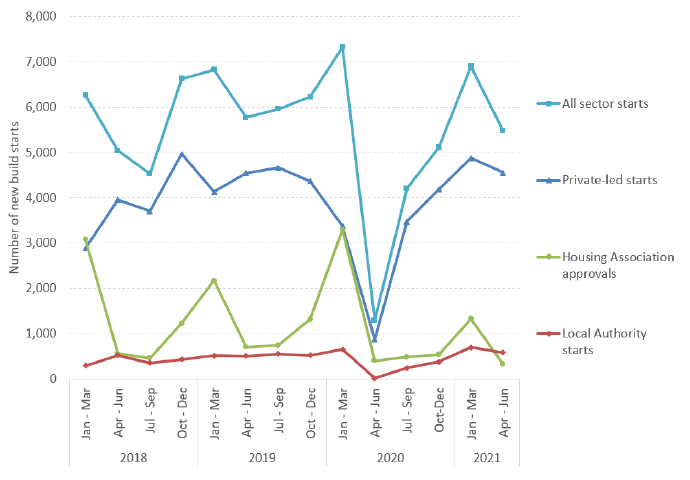
| All sector homes | Starts | Completions |
|---|---|---|
| Quarter Apr to Jun 2018 | 5,039 | 5,200 |
| Quarter Apr to Jun 2019 | 5,769 | 5,537 |
| Quarter Apr to Jun 2020 | 1,290 | 721 |
| Quarter Apr to Jun 2021 | 5,471 | 4,897 |
| Change from Q2 2020 to Q2 2021 | +4,181 | +4,176 |
| Change from 2020 to 2021 (%) | +324% | +579% |
| Year to Jun 2018 | 19,656 | 18,109 |
| Year to Jun 2019 | 23,754 | 21,603 |
| Year to Jun 2020 | 20,800 | 17,223 |
| Year to Jun 2021 | 21,686 | 18,974 |
| Change from 2020 to 2021 | +886 | +1,751 |
| Change from 2020 to 2021 (%) | +4% | +10% |
Map A below shows that in the year to end June 2021, the highest new build rates were observed in the local authority areas of Midlothian, East Lothian and Perth & Kinross, which had rates of more than 38 homes per 10,000 population.
The lowest rates were observed in Dumfries & Galloway, South Ayrshire, Stirling and Inverclyde, which had rates of 16 homes or fewer per 10,000 population.
Note that the all-sector completion rates calculations contain some estimated figures. Estimated figures have been used for private sector completions for East Dunbartonshire, South Ayrshire from October to December 2020, Angus, Glasgow City, and Highland from January to March 2021 and for Aberdeen City and North Ayrshire for April to June 2021.
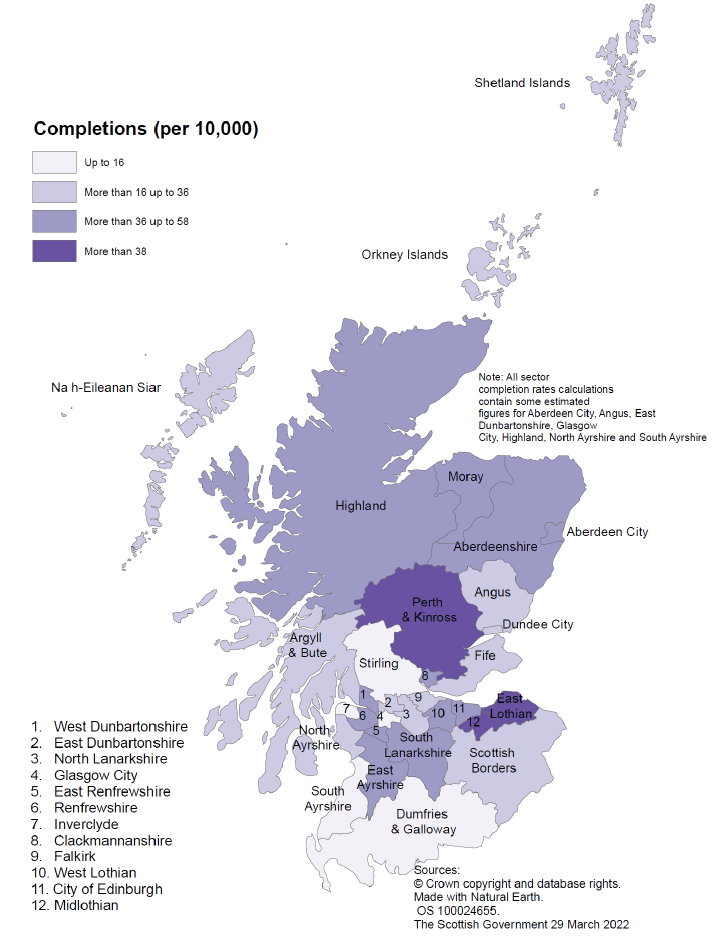
Chart 4a presents trends in the rates of new house building per 10,000 population across each of the UK countries on a financial year basis (years to end March) to allow for comparisons with both the England financial year 'net additional dwelling' statistics and financial year rates derived from each of the quarterly UK series.
The England financial year 'net additional dwellings' series is considered the primary and most comprehensive measure of housing supply in England. The quarterly new build statistical collection for England is not currently capturing all new build activity, and so is seen more as a leading indicator of activity throughout the year.
This shows that whilst Scotland had a higher rate of completions per 10,000 head of population than England over the period 2006/07 to 2013/14, that Scotland and England have seen broadly similar rates of housebuilding each year across the period 2014/15 to 2019/20, when comparing the Scotland figures to the England net addition figures.
Whilst all four countries have seen a decrease from 2019/20 to 2020/21 due to the impacts of COVID-19, Scotland has seen a sharper fall in 2020/21, down to a rate of 27 homes per 10,000 population, which may be due to the stricter lockdown restrictions that were in place for housing building in Scotland.
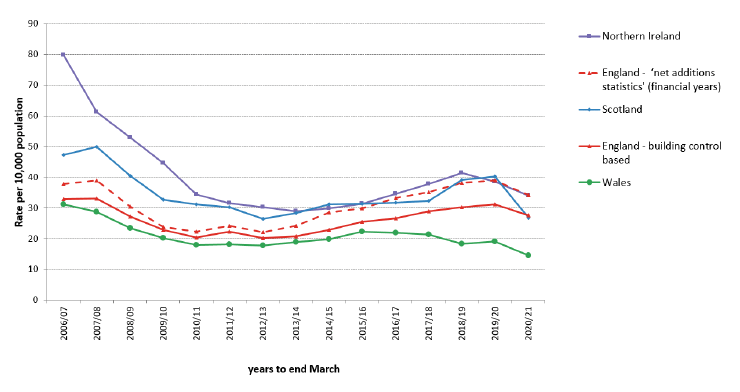
Chart 4b presents more recent trends in the rates of new housebuilding per 10,000 population across each of the UK countries on a quarterly basis, based on the latest published information available for each country[1]. The England 'net additional dwelling' figures for the financial year 2019/20 and 2020/21 is also included as an average across each of the quarters within this year, to help demonstrate the difference in the relative level between this figure and the separate quarterly England building control based figures.
The chart shows the clear impact of COVID-19 lockdown restrictions on construction activity in the quarter April to June 2020, with the rates of new housebuilding per 10,000 population dropping compared to the same in quarter in the previous year by 87% in Scotland, 64% in England (building control based figures), and 61% in Northern Ireland, which may reflect stricter lockdown restrictions for Scottish housing building compared to England and Northern Ireland.
Following this, the rates of new housebuilding in each of these countries subsequently increased back up to higher levels, although the quarterly rates for Scotland, England and Northern Ireland have shown a slight downward trend following the October to December 2020 quarter.
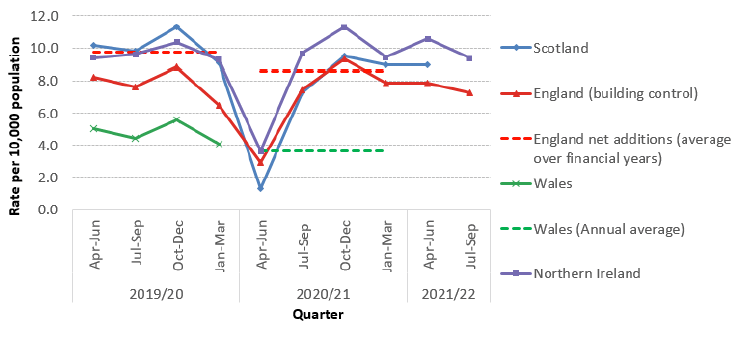
Contact
There is a problem
Thanks for your feedback